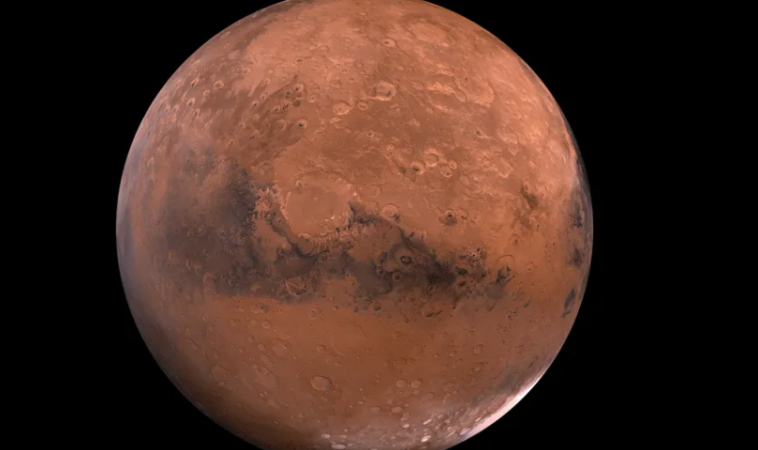Researchers have uncovered seismic evidence that may point to the presence of liquid water beneath Mars’ surface. By analyzing the echoes of "marsquakes"—seismic waves traveling through the planet’s crust—scientists identified signs of potential water near the bottom of Mars’ upper crust, between 3.4 and 5 miles (5.4 and 8 kilometers) deep.
“Mars has consistently remained a key focus in the quest for extraterrestrial life within our solar system,” said Weijia Sun, a professor at the Institute of Geology and Geophysics at the Chinese Academy of Sciences and a co-author of the study. “Liquid water is considered one of the most crucial ingredients in this search.”
Historically, Mars is believed to have had flowing water during its Noachian and Hesperian periods, which lasted until around 3 billion years ago. However, as the planet entered the Amazonian period, its climate changed dramatically. Surface water vanished, leaving behind the cold, dry terrain observed today.
“While we are certain that water once flowed on Mars, questions still remain about how much water existed and what mechanisms led to its disappearance,” Sun added.
One prevailing theory suggests that solar wind gradually stripped Mars’ atmosphere, causing water to escape into space. This theory is supported by isotope measurements on Mars. An alternative theory posits that the water wasn’t lost, but instead migrated underground, possibly forming deep aquifers. While models suggest water could still exist in the mid-crust, confirming this is difficult due to limited structural data from those depths.
Although radar-equipped rovers and orbiters have probed Mars’ surface, these tools can only penetrate a few miles into the crust because electromagnetic signals weaken with depth.
To overcome this limitation, Sun and his team turned to seismic data produced by two large meteorite impacts (S1000a and S1094b) and the largest marsquake ever recorded (S1222a). “Though earlier computational studies hinted at the possibility of subsurface liquid water, seismology provides observational support that was previously lacking,” Sun explained.
By studying how seismic waves traveled through Mars’ crust, the team mapped fine structural features and looked for irregularities that might signal liquid water. “We used a method called ‘receiver functions,’ which are essentially the echoes of seismic waves bouncing between layers in the crust—similar to how echoes can reveal the shape of a cave,” said Hrvoje Tkalčić, a professor at The Australian National University and another co-author.
“Unlike traditional receiver function analysis, we introduced true-amplitude imaging, a technique adapted from oil exploration that enhances resolution and enables the detection of finer structures,” Sun added. “This method acts like a magnifying glass, clarifying subsurface features more accurately.”
The study revealed a low-velocity layer between 3 to 5 miles (5 to 8 kilometers) underground, where seismic waves slow down significantly. Initially, this layer was suspected to be made of fractured sedimentary rock, which transmits seismic energy less effectively due to its flexibility. However, based on its depth and location within the crust, it likely isn’t sedimentary.
“Seismic waves travel faster through dry rock than through water-saturated rock,” Sun noted. The team now believes the slowed seismic waves may result from liquid water saturating a region of altered basalts—rocks known to be porous enough to hold water.
“Through a detailed analysis, we concluded that the low-velocity zone may be caused by the presence of liquid water, as temperatures at those depths likely exceed the freezing point,” Sun said.
Based on the data, the team estimated between 569 and 853 yards (520 to 780 meters) of Global Equivalent Layer (GEL) of water—an estimate of how deep water would be if spread evenly across the Martian surface. This estimate aligns with previous studies that suggested between 776 and 1,006 yards (710 to 920 meters) of GEL, which has not yet been explained by current water inventories on Mars.
“The discovery of subsurface water on Mars carries major implications for future human exploration and the search for extraterrestrial life,” Tkalčić said. However, reaching such deep reservoirs would require advanced drilling technology and significant energy resources.
The researchers emphasized that their findings are based on a single local profile beneath the InSight lander, located in the Elysium Planitia region near 4.5 degrees north of Mars’ equator. This means the results might be specific to that region and not indicative of the entire Martian crust.
“This limitation could be addressed by future missions deploying multiple seismometers on the Martian surface,” Tkalčić concluded.
Their study was published on April 25 in the journal National Science Review.

